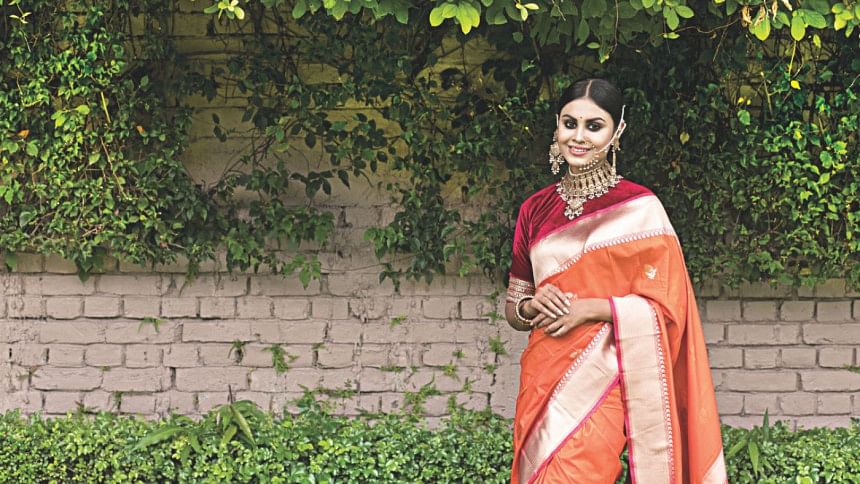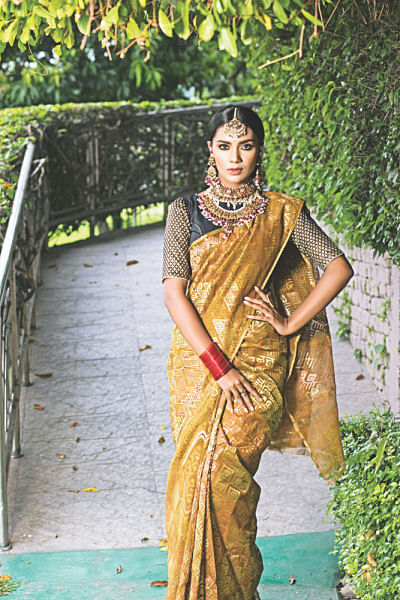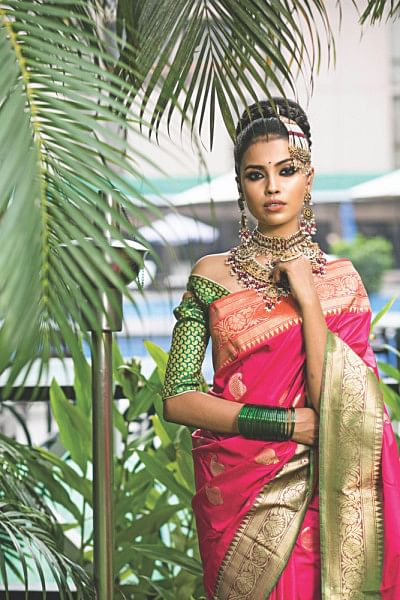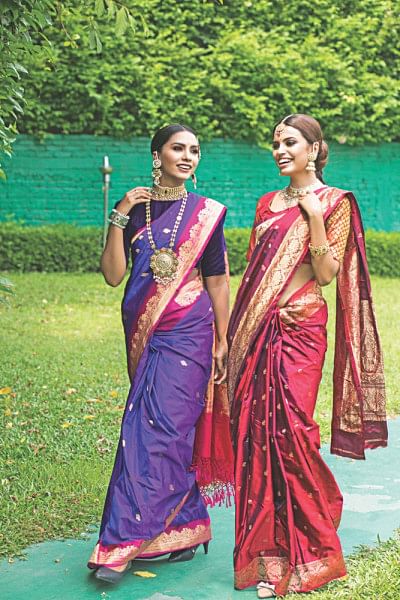The whole six yards

The ivory Chinese satin, embroidered with a border of flowers, the field scattered with birds and flowers, was what made the sari what it is — a living legend!
But, who is insane enough to spend such princely sums for a single sari, you may ask. The answer may baffle you; maybe take you off guard even.
As baffling as it may sound, saris have long been considered bona fide collectibles, and the pool of connoisseurs far outnumbers the supply of signature pieces. There has always been a demand, and what in Bangladesh gets handed down through generations, comes up at western auction houses.
The sari has captured the world's imagination, and one that grows more dynamic with each passing day. Its story can be traced back to the Indus Valley civilisation, and it has readily accepted and generously contributed to all cultures, so much so that the debate continues — did the Greeks influence the sari, or is it the other way round. And what about the Romans? Perhaps, all!
Every Bengali girl worth her salt appreciates a classy Jamdani when she sees one; some go the extra mile in buying one. A true sari lover is also quick to pick other exquisite pieces, and fully appreciate the fruit of love on the weaver's part. She understands the nuances that makes it elegant — the selection of thread, the abundant use of dyes, intricacy of the lavish embroidery, and the finish to perfection. Every aspect is key in the valuation, and once you are conscious of these nuances, a connoisseur is in the making.

'Collecting' is just a step further!
It would be wrong to assume that every woman is comfortable in a sari. A garb often taken for granted in everyday life, the sari remains the choice over the little black dress for most Bangladeshi femmes. Popular stars have chronicled the ever-changing facet of the sari; from minimalist cottons, to lavish silks, shimmering, heavy-duty embroidery bejewelled pieces, or opulent translucent net pieces. Openly partial to this stitch-less piece of fabric, they successfully create a formidable identity by wearing it.
Think beyond tradition, think beyond your grandma!
Do you see how easy it is; superlatively easy to just slip into the right sari. So effortlessly simple to create that traditional persona, or flirt with the in your face avatar to satiate the alter ego.
A sari can be sensuous without being raw; showy but iconic. Any sari can be refashioned to one's daily needs. It is astonishing that there are perhaps as many draping styles as there are sari variants. Street smart fashionistas who just want to be the centre of almost everything, or a lady who chooses to leave the panache, the ostentation, even as they leave the hall — the sari has something for everyone.
Ideally, there should not be any bias in fashion, but there is more to style than following trends; more to being a collector than hoarding every beautiful piece that one comes across. To state the difference in a somewhat blatant fashion — connoisseurs are keen observers of changes they see; collectors simply augment that experience by buying one of the changes for themselves.
A collector treats a Jamdani, a piece of Pabna beethi, or a Cumilla khaadi with equal enthusiasm, but her weakness for Banarasis may be well justified. The rule of thumb of collecting is that every wardrobe has to tell a story, and each piece — at least a page.

A collector may keep and wear taant simply because of its comfort factor, but she collects them solely for their versatility. With time, her assembly of taant may grow, and thus, she can simply turn the page into a lucid chapter.
While she may buy taants online for every day wear, her finest handloom pieces are handpicked, each connected by a story — not necessarily a historical account, but perhaps a personal one.
If she does pick powered looms, it is to tell the ever changing image of the sari — not necessarily to promote the capitalist grip on rural artisans and their masterful craft.
Now, think Chanderi, Kosa, Kanchipuram — all being magnificent use of the best available silk yarns, and each being iconic symbols of finest craftsmanship. We are quick to pick the silk connection with the Kanchipuram, but how many are aware that the beauty of the 'heaviest silk known' is attributed to the river that flows by Kanchipuram city. Yet, how many confuse silk with modern day chiffons and Georgettes, even when they turn heads wearing them?
A sari aficionado may not understand the link, and possibly it has been lost, but even signature Garas seem strikingly similar to the florals, wild prints, and polka dots of these days. What we see today are just concepts build upon ideas of the previous era… one that goes thousands of years back in known time.
Even three decades ago, the nakshi-kantha stitch on saris was unheard of. Truly, it is a modern innovation. A fusion that brought two of our most passionate crafts, and what a splendid confluence of methods it has been! Today, they have a place in every sari fan's trousseau.
Now, why keep it? To chronicle history maybe… or simply because of intricacy of the embroidery, or the stitching technique, or plain love for pastoral motifs — each collector defines her own parameters.

It was in the '50s that famed designer Valentino gave the traditional sari its first western twist, and the sari dress was born. Today, Hermès store in India sell exclusive line of saris. One may choose to wait 20 years, or pick one now. But one does not need to own a Hermès to appreciate its beauty, and appreciate that as far as the sari is concerned, we are witnessing history in the making.
For a collector, there are no set rules. One does not need a degree in sericulture to appreciate the difference between the Muga and the Eri, or understand the botany behind the difference between Tangail handloom and the myth-like Muslin, all in cotton.
Just like all lessons for life, the same are true for the sari collector. Be what you are, wear what you feel does justice to you, and your inner being.
Collect prints? By all means, but only if it appeals to you.
Be patriotic, or choose to be cosmopolitan — it is for you to decide.
The best thing about being a collector of saris is that once in a while, you get to wear them and exude grace, panache, and of course, some sex-appeal.
Model: Meghla
Photo: Sazzad Ibne Sayed
Wardrobe: Tangail Saree Kutir Ltd
Blouse: Jahin Khan
Make-up: Farzana Shakil's Makeover Salon
Styling: Sonia Yeasmin Isha
Jewellery: Araaz
(Road # 30, House # 12, Gulshan-1, Dhaka-1212
Cell: 01746-660011
E-mail: [email protected])
Location: Pan Pacific Sonargaon, Dhaka

 For all latest news, follow The Daily Star's Google News channel.
For all latest news, follow The Daily Star's Google News channel. 



Comments